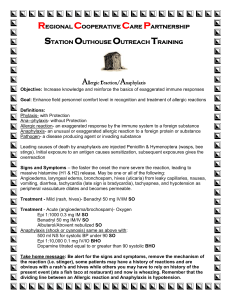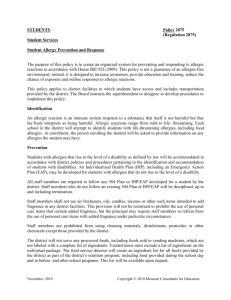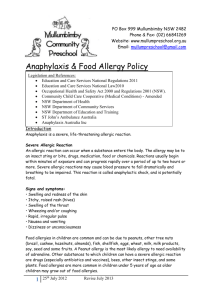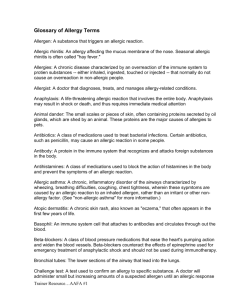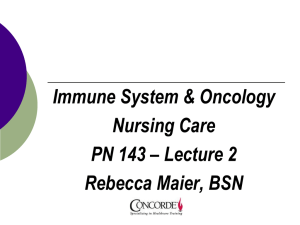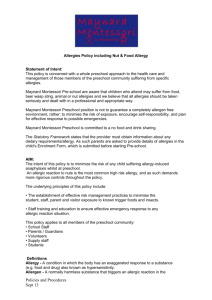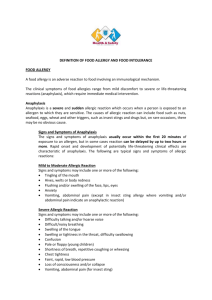Allergy PowerPoint
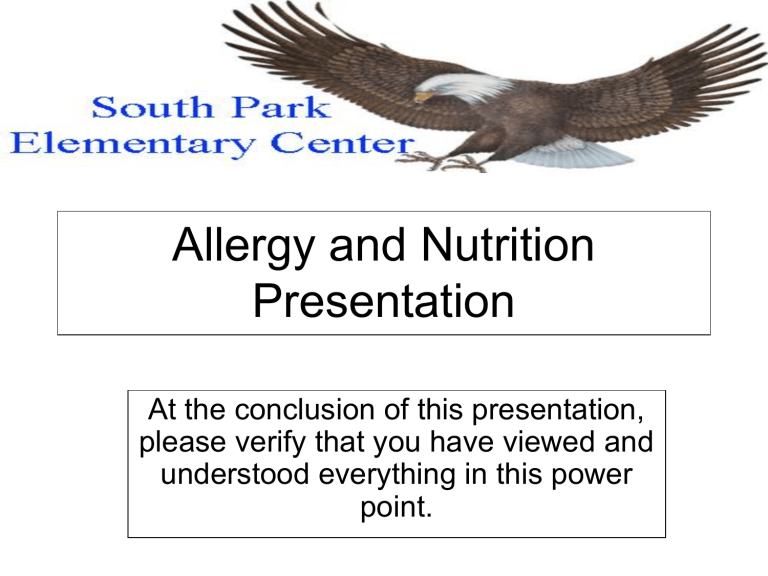
Allergy and Nutrition
Presentation
At the conclusion of this presentation, please verify that you have viewed and understood everything in this power point.
Allergic Reactions
• The body’s response to an allergen that causes the body to treat the allergen as a foreign or unfriendly substance.
• The body naturally wants to protect itself and releases antibodies to counter the perceived invasion.
• As the immune system reacts, symptoms occur.
Anaphlaxis
• Anaphylaxis is a life-threatening allergic reaction that affects millions of Americans every year. Anaphylaxis can be caused by a variety of allergens , with the most common being food , medications , insect venom , and latex .
Latex
•
Latex allergy is an allergic sensitivity to the proteins in natural rubber latex (NRL) that often worsens with each exposure and at its most severe can result in deadly anaphylaxis. Unlike synthetic latex, which rarely causes allergic reactions, NRL comes from the milky sap of rubber trees. Using various processing techniques, NRL is used alone or in combination with other materials to make thousands of products including:
•
Car tires, Rubber bands, Carpet backing
• Hospital and dental equipment
•
Dipped latex products are the biggest culprits in triggering allergic reactions, including:
•
Gloves
•
Balloons
Food Allergies
• The most common type of severe allergy.
• The incidence has doubled in the U.S. over the last 10 years.
• Scientist do not know why.
• There is presently no cure for food allergies.
Strict avoidance is the only way to prevent a reaction.
• Early administration of epinephrine (EpiPen) is the key to treating anaphylaxis.
Food Allergies
Eight foods account for 90% of all food allergic reactions in the U.S.
• Peanuts
• Tree nuts (walnuts, almonds, cashews, pistachios and pecans)
• Milk
• Eggs
• Wheat
• Soy
• Fish
• Shellfish
Avoiding an allergic reaction
• Any amount of an allergen must be avoided. As little as 1/5000 of a teaspoon can cause a severe reaction.
• Cross contamination (using the same utensil or cutting surface) can introduce an allergen.
• Reactions can also occur from skin contact and inhalation.
Symptoms of a reaction
• Swelling of lips and/or airway.
• Wheezing, difficulty breathing.
• Stomach cramps, vomiting, diarrhea.
• Skin rashes or hives.
• Loss of consciousness.
How to use an EpiPen
• Call 911. The effects of the epinephrine may wear off in as soon as 15 minutes.
What can you do?
• Know which students have allergies.
• Keep a list of these students in your substitute folder.
• Review lesson plans that involve food.
• Use non-food items for rewards.
• Students with allergies should only eat food provided (or approved) by their family.
• Plan ahead with volunteers if food will be provided
(parties, ect.).
CLASSROOM SNACKS:
Due to the number of food allergies and dietary restrictions of our students, food treats brought from home will not be passed out in the classroom. If your child is celebrating a special day we strongly encourage non-food items for treats. If you send in a food item it must be individually wrapped so that it can be sent home. Treats that are not individually wrapped will not be passed out.
Guidelines for Foods Offered in the Classroom
Classroom Activities will offer minimal amounts of foods ( max. of 2) that contain added sugar as the first ingredient and may provide the following:
-Fresh Fruits and Vegetables
-Water, 100% fruit Juice or Milk
In addition foods offered:
-Must be moderate in sodium content
-Provide minimal to no trans fatty acids
-Provide items that contain >2 grams of fiber/serving
Do not offer any “ Foods of Minimal Nutritional Value”
Added Sugars (no more than 2 item with these as their first ingredient)
Brown Sugar
Lactose
Dextrose
Molasses
Glucose
Sugar
Invert Sugar
Corn Syrup
Malt Syrup
Corn Sweetener
Maltose
Fructose
Fruit Juice Concentrate Raw Sugar
Sucrose
Honey
High Fructose Corn Syrup
Syrup
Foods of Minimal Nutritional Value
Soda Water Water Ices
Candy Jellies
Fondant (ex. Candy corn) Licorice
Candy Coated Popcorn
Chewing Gum
Marshmallow Candies
Spun Candy
Severe Animal Allergies
Animals in the building:
• No animals are allowed in the building for an extended period of time.
• No class pets.
• If students want to bring in their pet for a “student of the week” the animal must be left outside and the students may be taken out to the pet.
• At the conclusion of the pet presentation, EVERY student must wash their hands before entering the classroom.




